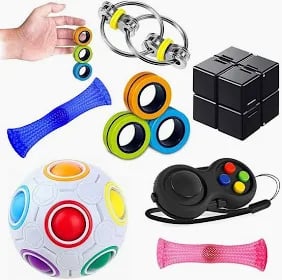10 Pocket Coping Skills for Anxiety
Anxiety often shows up uninvited at work, in traffic, in social settings, or during quiet moments alone. It can feel overwhelming and hard to control. That’s why having a set of simple, fast-acting coping tools "pocket skills" can make all the difference. These skills are designed to help you interrupt anxious thinking, calm your body, and return to the present moment. They work by activating your body’s calming response (the parasympathetic nervous system), helping you feel more grounded, in control, and safe.
All In Health
9/13/20254 min read
Here are 10 quick and effective pocket skills for managing anxiety each with a simple explanation of why it works.
1. Box/Square Breathing
Why it helps: This deep breathing technique helps regulate your nervous system, reduce physical symptoms of anxiety (like rapid heartbeat), and shift your body out of "fight-or-flight" mode.
How to do it:
Inhale for 4 seconds
Hold your breath for 4 seconds
Exhale for 4 seconds
Hold for 4 seconds
Repeat 4–6 rounds.
2. 5-4-3-2-1 Grounding Technique
Why it helps: Anxiety pulls your mind into the future this grounding technique brings it back to the present using your five senses.
How to do it:
Name 5 things you can see
Name 4 things you can touch
Name 3 things you can hear
Name 2 things you can smell
Name 1 thing you can taste




3. Tense & Release (Muscle Relaxation)
Why it helps: Anxiety causes muscle tension. This technique helps you notice and then release that tension, giving your brain a physical cue to relax.
How to do it:
Clench your fists tightly for 5 seconds, then release
Shrug your shoulders up, hold, then drop
Repeat with jaw, toes, or other areas
4. Finger Tap Counting
Why it helps: The rhythmic motion of finger tapping helps calm your nervous system and redirect mental energy away from racing thoughts.
How to do it:
Tap your thumb to each finger in order while silently saying: “1, 2, 3, 4” or a calming phrase like “I am safe”
Repeat for 1–2 minutes




5. Name 3 Things You Can Control
Why it helps: Anxiety often focuses on uncertainty and what we can’t control. This skill reminds your brain of small, manageable things you can influence.
How to do it:
Say out loud or write down:
“I can control my breathing, my posture, and whether I take a break.”
This shifts your attention from helplessness to empowerment.
6. Breathe with Your Hands
Why it helps: This combines deep breathing with physical movement, making it easier to stay focused and regulate your breath.
How to do it:
Hold one hand up like a star
Use the finger of the other hand to trace each finger slowly
Breathe in as you trace up, breathe out as you trace down
Repeat for all five fingers




7. Count Backwards by 7s
Why it helps: Doing a mild mental challenge like this distracts your mind from anxious thoughts and brings your logical brain back online.
How to do it:
Start at 100 and count backward by 7 (100, 93, 86, etc.) for 30–60 seconds.
8. Cold Water Splash or Ice Hold
Why it helps: Cold activates the “dive reflex,” slowing your heart rate and calming your body instantly. It’s a physical shock that disrupts mental overwhelm.
How to do it:
Splash cold water on your face
Or hold an ice cube in your hand until it melts




9. Breath Focus with a Phrase
Why it helps: Pairing breath with calming language strengthens your mental focus and sends reassuring signals to your brain.
How to do it:
Inhale slowly and say, “Breathe in calm”
Exhale slowly and say, “Breathe out fear”
Repeat for 5–10 breaths
10. Grounding Object in Your Pocket
Why it helps: Touching a small, familiar object can anchor you in the moment and give your hands something to focus on instead of fidgeting or panic.
How to do it:
Keep a small item (like a smooth stone or textured keychain) in your pocket
When anxious, hold it and focus on its texture, temperature, and shape




Anxiety doesn’t have to control your day. These “pocket skills” are small, powerful tools that help you manage symptoms wherever you are. The more you practice them, the more confident and in control you’ll feel when anxiety arises. At All in Health, we believe in empowering individuals with real-world tools and personalized support for lasting emotional wellness. Pocket skills are a great step; therapy, coaching, and community support take it even further.
You are not alone. You are not broken. You have tools.
Click below for a printable version of this list.
GET STARTED TODAY
Your journey. Our commitment. Together, we’re all in.
STAY IN TOUCH
Contact Us
954-445-1567
© 2024. All rights reserved.
